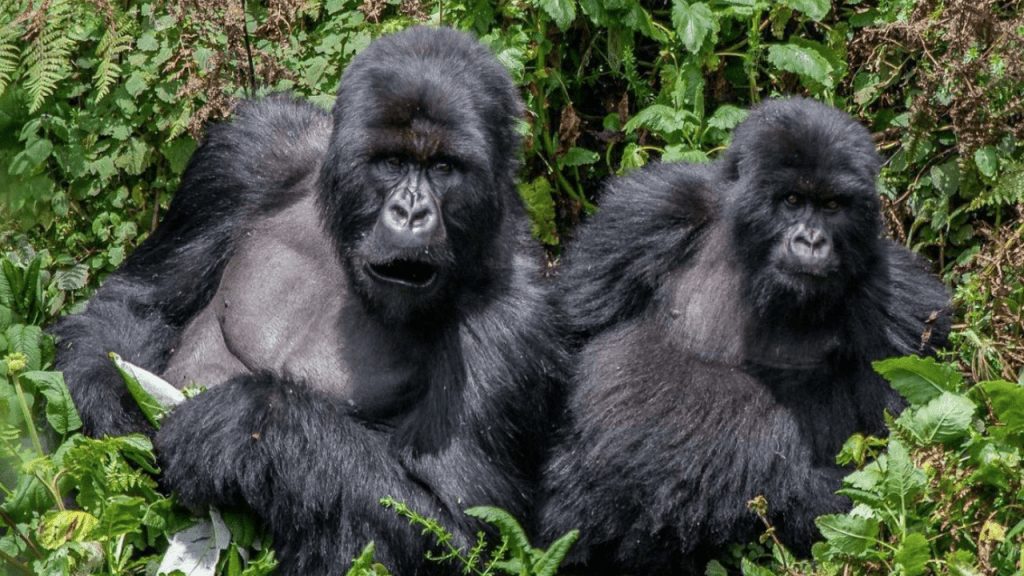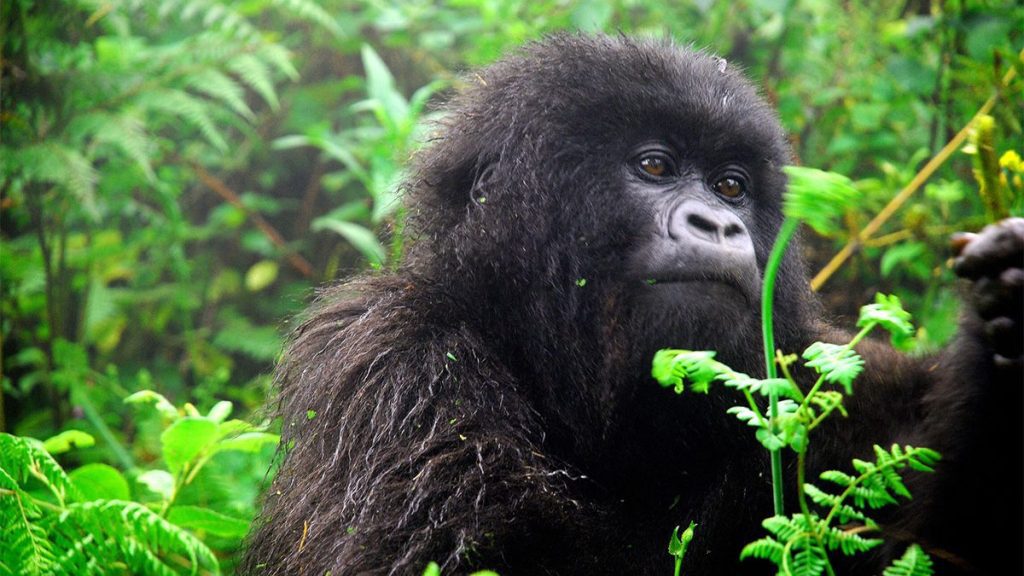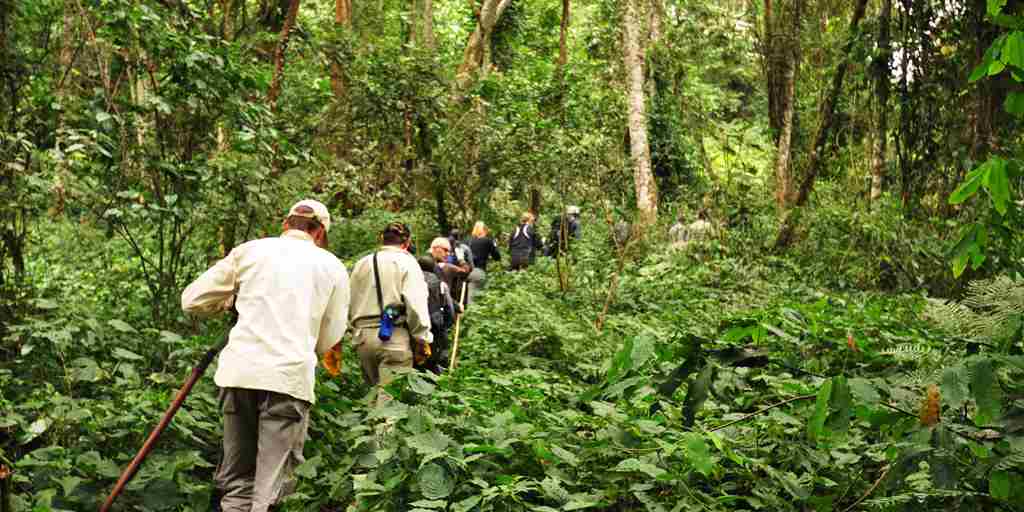DISCOVER AFRICA
Gorilla Conservation in Uganda Rwanda and the Democratic Republic of Congo
The last mountain gorillas can be found in the high rainforests of central Africa. Mountain gorillas are now critically endangered, with only a few thousand remaining. They only have one home, a network of gorilla parks spanning the borders of Rwanda, Uganda, and the Democratic Republic of the Congo. The conservation status of gorillas in Africa is favorable, as more groups pool resources and the number of primates grows. Africa is home to a range of animal species that have provided significant social and economic benefits throughout the years, making Africa one of the world’s major tourism destinations.
Despite these enormous benefits, African wildlife species are on the verge of extinction, with the Mountain gorilla, Ethiopian wolf, Black Rhino, Rothschild’s Giraffe, Chimpanzee, African Penguin, Riverine Rabbit, African Wild Dog, and Pickergrill’s Reedfrog among those on the International Union for Conservation of Nature’s (IUCN) Red List of Threatened Species.
About Gorilla Conservation in Uganda Rwanda and Congo.
Mountain gorillas are one of four species of gorillas found in the Virunga volcanic highlands in south-western Uganda, north-west Rwanda, and the eastern Democratic Republic of the Congo. The lowland and mountain gorillas are the two primary species. The Eastern and Western Lowland gorillas are the two subspecies of lowland gorillas. Mountain gorillas may be found in four national parks: Uganda’s Mgahinga Gorilla National Park, Uganda’s Bwindi Impenetrable National Park, Congo’s Virunga National Park, and Rwanda’s Volcanoes National Park. Mountain gorillas, who are mostly terrestrial and quadrupedal, have longer and thicker fur than lowland gorillas, allowing them to adapt to colder weather.
Adult male gorillas have a more noticeable bony crest, as well as gray and silver colored hair on their backs that grows with age, therefore the name silverback. Mountain gorillas weigh between 195kg to 200kg, which is twice as much as females. They have arms that are longer than their legs and move in a knuckle walking stance, supporting their weight on the backs of their curled fingers.
Factors threatening the survival of Gorilla populations in Uganda Rwanda and Congo.
Despite these optimistic data of progressively increasing mountain gorilla populations in recent years, these big apes nevertheless face a variety of risks originating from human actions that are thought to have almost wiped out the primates in the early 1970s. These risks can be broadly characterized as mostly human-caused social, economic, and political problems.
Habitat Loss/Encroachment on Gorilla Territory.
Humans have cleared ground for crops and cattle as they have expanded into places near mountain gorillas. Even land within protected areas is not immune to clearing; for example, in 2004, illegal squatters destroyed 3,700 acres of gorilla woodland in Virunga National Park.
Increased human connections with mountain gorillas in terms of towns and tourism activities such as gorilla trekking enhance the likelihood of these mountain gorillas contracting human infectious diseases such as pneumonia, flu, and, most recently, Ebola.


Disease
Disease has been responsible for at least 20% of gorilla population deaths. Humans’ increased economic requirements have resulted in an increase in poaching utilizing traps and snares.
Poaching
Poaching may be profitable because mountain gorillas, particularly infants, can cost up to $5000 on the illicit market. Mountain gorillas are rarely directly targeted for bush meat or the pet trade, although they can be trapped and damaged by snares laid for other animals.
Political unrest/Insecurity
Another factor to consider is the significant threat presented to mountain gorillas as a result of political upheaval and civil wars observed in Uganda, Rwanda, and the Democratic Republic of the Congo during the previous decades. When gorillas come into touch with humans, they can become infected with human illnesses, which gorillas can experience in more severe forms. Mountain gorillas can succumb to the ordinary cold.
Mountain gorilla families that are routinely familiarized with researchers and visitors, on the other hand, have fared better than unvisited gorillas; they benefit from the higher protection afforded in those regions, as well as regular monitoring. Improved veterinary treatment for sick and injured gorillas has also contributed to increased survival.


Charcoal Making
People scavenge charcoal inside gorilla habitat in Virunga National Park to use as a fuel source for cooking and heating. This charcoal manufacture, a multi-million-dollar illicit enterprise, has decimated gorilla habitat.
How Gorilla Conservation has improved gorilla populations in Uganda, Rwanda and Congo?
The Mountain gorilla population fluctuated between 1959 and 1960. George Schaller conducted the first gorilla census, which predicted 400 to 500 gorillas in the Virunga protected area. This was followed by Dian Fossey and her Karisoke Research Center team’s gorilla censuses in 1971 and 1973, which revealed a substantial fall in gorilla populations down to 250. This decrease was attributed to increasing poaching as well as the conversion of up to 40% of the National Park territory to agricultural cultivates. Bwindi Impenetrable Forest Gorilla Census in Uganda. The Karisoke Research Center in Rwanda conducted a census in 1978 and discovered around 260 gorillas, including 42 infants under the age of three.
Following Dian Fossey’s death in 1985, the number climbed to around 320 in Bwindi impenetrable forest and 324 in the Virunga conservation area during the 1989 census. In the Virunga protected area, the number progressively increased to 380 and 480 in 2003 and 2010, respectively, representing a 26.3% rise in gorilla population during a seven-year period.
Unlike the Virunga volcanoes, the Bwindi impenetrable forest census was conducted differently, with the 1997 gorilla census indicating a total of 300 individuals, increasing to 320 in 2002. In the 2006 population census, this figure had dropped to 302. In the 2006 gorilla census, 682 mountain gorillas were detected in both the Virunga area and Bwindi impenetrable national parks, with a further 138 rise in 2012 and over 1000 mountain gorillas in the wild in the most recent 2018 gorilla census.
Currently, the global mountain gorilla population stands at 1,063 individuals; with about 459 gorillas found in Bwindi Impenetrable National Park in Uganda, and the neighboring Sarambwe Nature Reserve in the Democratic Republic of Congo, as well as 604 individuals inhabiting the Virunga Massif.
Dian Fossey’s Contribution to Gorilla Conservation in Uganda, Rwanda and Congo.
Dian Fossey is widely regarded as one of the best primatologists of all time. Dian Fossey became interested in visiting Africa after seeing images of a friend’s vacation to the continent. In 1963, she went on a safari in Africa. Her itinerary includes stops in Kenya, Tanzania, Zimbabwe, and the Democratic Republic of the Congo. She met the famed archaeologist Louis Leakey when visiting the Olduvai Gorge in Tanzania. They had a pleasant conservation, and one of the topics they discussed was Jane Goodall’s outstanding work with chimpanzees.
Dian became interested in primatology, particularly the big apes. Dian Fossey adored mountain gorillas beyond any other creatures. Leakey pushed her to research mountain gorillas and was eager to publicize her findings. She arrived in the Virunga conservation region in 1967 and established her base between Mount Bisoke and Karisimbi. She developed the Karisoke Research Centre by combining the names of the two mountains. The research center began in a hut and developed to include distinct facilities. Her first gorilla interaction was with Digit, a five-year-old male gorilla. She paid great attention to it, and they began to build a cordial friendship.
She began making friends with additional gorillas after discovering that they were friendly and warm animals. Later, she conducted the first gorilla census in the Virunga protected region. The census findings revealed that the number of mountain gorillas has decreased dramatically, and they may go extinct if nothing is done to combat poaching and habitat encroachment. She brought the suffering of mountain gorillas to the attention of the world and urged animal conservation organizations to assist. Dian Fossey’s first goal was study, but she later shifted and enlarged her work to include gorilla conservation. She devised three ways to gorilla conservation: proactive, communal, and theoretical. She battled animal/pet traffickers and poachers diligently as part of her proactive strategy. She rallied her troops to smash snares created by poachers in gorilla habitats. Dian Fossey also called for nations to enact tough anti-poaching legislation.
She even treated sick and injured gorillas found in the jungle. Under the theoretical method, she documented her gorilla study findings and published them in prestigious publications, attracting the attention of those eager to fund her work. Financial assistance was provided, as well as volunteers for her study center at Karisoke. Dian Fossey also urged visitors from all around the globe to come see the gorillas in their natural habitat. Although she eventually opposed gorilla tourism and urged for gorillas to be left alone in the wild, Dian Fossey pioneered the concept of gorilla trekking.
Using the proceeds from gorilla tourism, Fossey engaged the local people/community by constructing social services (schools, clinics, and water supplies). She also hired them for her research facility, gaining their support in the wider battle against poaching. Dian Fossey was killed in her cabin by unknown individuals in 1985. There are rumors that her death was carried out as an act of vengeance by those who profited from poaching and animal trafficking.
How Gorilla Trekking contributes to Gorilla Conservation in Uganda, Rwanda and Congo?
In the 1990s, the governments of Uganda, Rwanda, and Congo met with gorilla conservation organizations to devise a strategy for introducing gorillas to the rest of the world through gorilla tourism. Allowing visitors like yourself to see the primates and great apes would not only earn funding for conservation, but would also educate local populations living near gorilla habitats about the need of maintaining the primates. Gorilla tourism would assist to develop jobs and deliver essential initiatives to communities.
The world welcomed the gorilla trekking tourism idea, and mountain gorilla trekking is today one of the world’s most popular wildlife activities. Thousands of visitors visit Africa each year to track gorillas. Many had been overheard claiming it was the most incredible animal experience they had ever had.
Other initiatives, such as integrating communities in decision-making and raising awareness about the need of animal conservation, have also taken root. In addition to community-based activities such as enhanced housing and infrastructure, park headquarters have been renovated to boost visitors. Other gorilla conservation operations include periodic gorilla census counts in concentrated mountain gorilla habitats, ranger patrols, trap disabling, on-the-ground law enforcement, and protected area protections.

What exactly is gorilla trekking?
Gorilla trekking entails venturing deep into the jungles of Uganda, Rwanda, and the Democratic Republic of the Congo in pursuit of a family of mountain gorillas. The exercise is conducted by park Rangers and can last between 2 and 6 hours depending on the gorilla troop. They only have one hour to witness the gorillas feed, groom, mate, play, and relax once they discover them. For a more in-depth encounter, sign up for the gorilla habituation experience. This is an experience that can only be had in Bwindi Impenetrable National Park.
How much is a gorilla trekking permit in Uganda, Rwanda and Congo?
The authorities are in charge of gorilla conservation include Rwanda Development Board, the Uganda Wildlife Authority, and the Congo’s Virunga National Park. Rwanda charges $1500 for gorilla trekking permit, whereas Uganda charges $700. In Congo, gorilla permit cost $450.
In summary; Mountain Gorilla tourism is an essential asset to the nations where they are found since it provides a competitive edge over adjacent countries in terms of income. As a result, Rwanda, Uganda, and the Democratic Republic of the Congo must coordinate tourist and conservation efforts in order to reap the full advantages of gorilla trekking.







